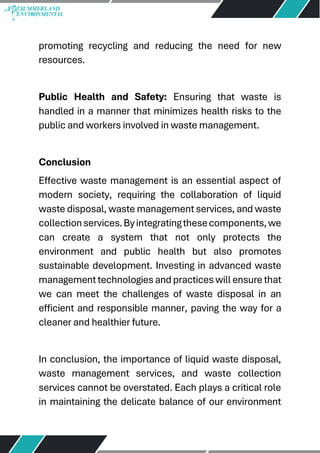5 Easy Facts About Reclaim Waste Described
5 Easy Facts About Reclaim Waste Described
Blog Article
The smart Trick of Reclaim Waste That Nobody is Discussing
Table of ContentsAn Unbiased View of Reclaim WasteExamine This Report about Reclaim WasteSome Ideas on Reclaim Waste You Should KnowAll about Reclaim WasteThe Basic Principles Of Reclaim Waste
Domestic sewage waste refers to the waste and items from a residential septic storage tank. The correct administration and disposal of residential sewer waste require liquid waste to be moved to a sewer treatment plant where the appropriate approaches and equipment are applied to detoxify and dispose of waste.
Commercial waste typically consists of possible hazards, such as combustible products or a mixture of fluid and strong waste products, and calls for an advanced and in-depth disposal process. The disposal of business waste typically includes the filtering of waste prior to transport to make certain safe and proper disposal. Industrial waste is produced from results and drainage of commercial procedures and manufacturing.
This sort of waste can not utilize the same sewer management transportation or procedures as septic or business fluids. The hazardous waste monitoring procedure calls for the inspection and testing of liquid waste before it undergoes the disposal procedure (liquid waste removal melbourne). Overflow waste is the liquid waste that comes from runoff and excess stormwater in highly booming locations or cities
Drainage waste can create contamination and flooding otherwise handled correctly. Discover more regarding drain cleaning and waste monitoring. Making certain appropriate waste management can prevent disasters and reduce ecological damage. Both individuals in domestic settings and specialists in industrial or production industries can benefit from recognizing the procedures and policies of liquid waste administration.
5 Simple Techniques For Reclaim Waste
Get in touch with PROS Providers today to discover our waste management and disposal services and the appropriate methods to care for the fluid waste you generate.
(https://www.anyflip.com/homepage/imqzz#About)Do you know what takes place to your water when you disengage, flush the commode or drain pipes the washing maker? No? Well, it's worth understanding. This supposed 'wastewater' is not only an important resource but, after therapy, will be released to our land, rivers or the ocean. Utilized water from commodes, showers, baths, kitchen area sinks, washings and commercial processes is called wastewater.

water utilized to cool machinery or clean plant and tools). Stormwater, a form of wastewater, is drainage that streams from farming and metropolitan locations such as roofings, parks, yards, roads, paths and seamless gutters into stormwater drains, after rainfall. Stormwater moves neglected directly to regional creeks or rivers, at some point reaching the ocean.
Little Known Facts About Reclaim Waste.
In Queensland, most wastewater is treated at sewage treatment plants. Wastewater is moved from residential or commercial websites via a system of sewers and pump stations, known as sewerage reticulation, to a sewage therapy plant. City governments construct, keep and run most sewer treatment plants. Operators are certified under the Environmental Security Act 1994 to discharge treated wastewater at an acceptable environmental standard anonymous into waterways.
The Department of Natural Resources recommends city governments concerning handling, operating and keeping sewage systems and treatment plants. In unsewered areas, city governments might call for homeowners to install specific or family sewage therapy systems to deal with domestic wastewater from commodes, cooking areas, shower rooms and laundries. The Division of Natural Resources authorizes using house systems when they are shown to be effective.
In some new subdivisions, therapy of some stormwater to eliminate litter, sand and crushed rock has begun using gross toxin catches. Wastewater treatment happens in 4 phases: Eliminates solid issue.
Wastewater then streams right into large containers where solids settle and are eliminated as sludge. Oil and scum are skimmed from the surface. Makes use of tiny living microorganisms called micro-organisms to break down and eliminate staying liquified wastes and great particles. Micro-organisms and wastes are integrated in the sludge. Gets rid of nitrogen and phosphorus nutrients that could cause algal flowers in our rivers and threaten aquatic life.
Reclaim Waste for Beginners
Nutrient removal is not offered in all sewer treatment plants since it calls for pricey specialized tools. It is coming to be more usual in Queensland. Clear fluid effluent generated after therapy may still consist of disease-causing micro-organisms. If this effluent is released into waterways such as rivers or the sea, the micro-organisms will ultimately pass away out.

Most wastewater moves into the sewage system. Under the Act, neighborhood governments carry out approvals and permits for environmentally appropriate activities (Ages) entailing wastewater releases that could have a local effect.
The 2-Minute Rule for Reclaim Waste
Surveillance supplies valid info about water high quality and can validate that permit problems are being met. The information obtained through surveillance offers the basis for making water quality choices.
Report this page